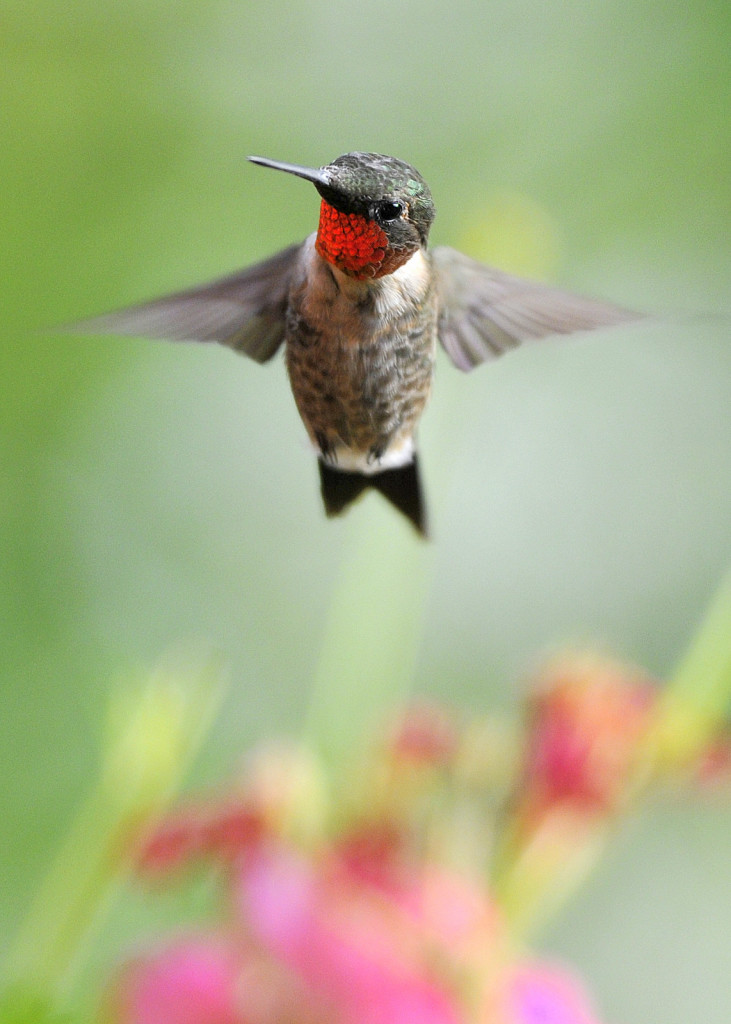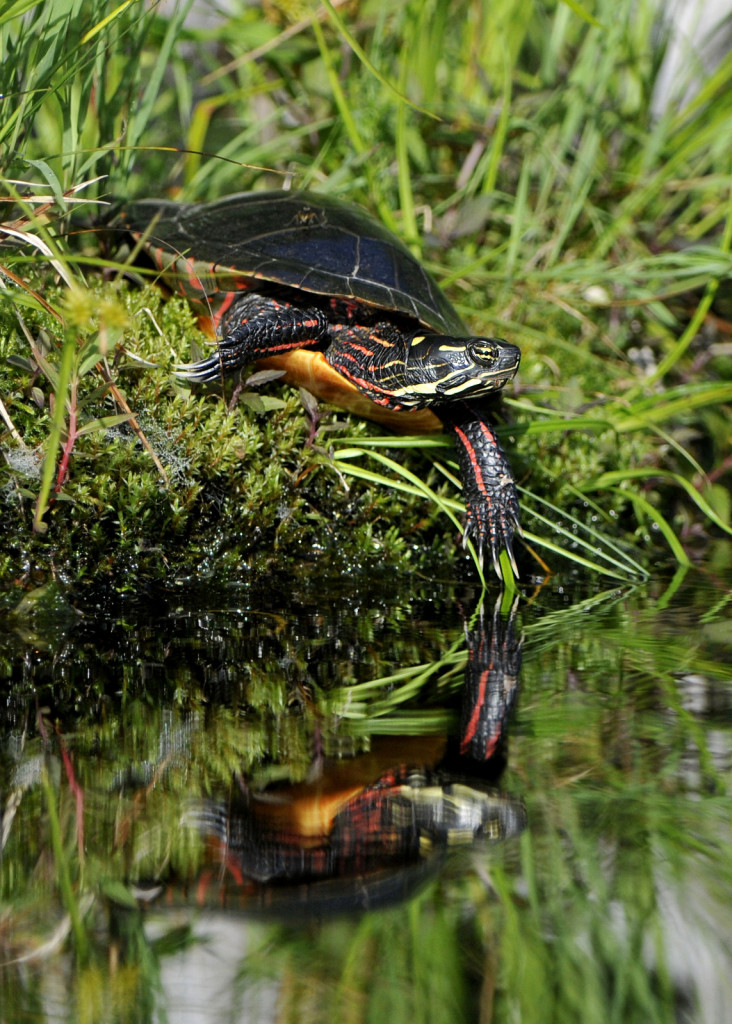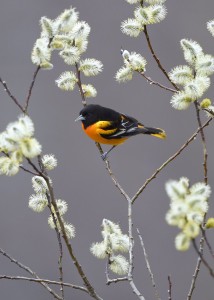11
Here is a short video on my photo trip to Maine last week:
Shot of the Month – July 2015
 Hummingbirds are the tiny flying jewels of the New World — all 340 known species are distributed among North and South America and the Caribbean. Alas, this wealth is not shared equally. In the eastern US (i.e., east of the Mississippi River) we only have one breeding species, the Ruby-throated hummingbird (RTH), as photographed here in our garden in Vermont. The wealth is shared thusly:
Hummingbirds are the tiny flying jewels of the New World — all 340 known species are distributed among North and South America and the Caribbean. Alas, this wealth is not shared equally. In the eastern US (i.e., east of the Mississippi River) we only have one breeding species, the Ruby-throated hummingbird (RTH), as photographed here in our garden in Vermont. The wealth is shared thusly:
Ecuador: 163 known species (the clear winner)
Columbia: 127 known species
Mexico: 50 known species
North America: 23 known species (most are found west of the Rocky Mountains and south of the US-Mexico border)
The wee birds can be found from southeastern Alaska and western Canada through the United States and Central America (including the Caribbean islands) down to Tierra del Fuego at the southernmost point of South America. The few species that do breed in the US and Canada migrate south to Mexico, Central America, West Indies, and southern Florida for the winter.
Here is a good map showing the distribution of the Ruby-throated hummingbird.
In the spring many RTHs pass through the Yucatan Peninsula of Mexico and fly across the Gulf of Mexico to reach Florida or Louisiana before continuing north. That is a 500-mile non-stop flight over water.
That is also, insane.
A bit of perspective. A RTH weighs about 3 grams. Put a US nickel in your hand — that is about 5 grams. (No, really, I mean it, go find a nickel and hold it. I can wait…….Crazy, right?)
Before departure, the birds go on an eating binge and double their weight to 6 grams. After completing the 20-22 hour, non-stop flight the bird may only weigh 2.5 grams! Once on the mainland, the birds average about 20 miles per day as they continue north. (Source)
In the spring you can use this great map to follow the migration of the Ruby-throated hummingbird.
Until next month…..m
Fade to black as I sit here shaking my head trying to imagine a nickel (with wings, of course) flying 500 miles across open water….
Other Coin Weights for my International Readers:
UK Penny = 3.56 grams
0.10 Euro coin = 4.10 grams
0.05 Euro coin = 3.97 grams
0.02 Euro coin = 3.0 grams
Kenya 10 Shillings coin = 5 grams
Kenya 5 Shillings coin = 3.4 grams
1 Indian Rupee = 4.85 grams
Nikon D300s, Nikon 70-200mm f/2.8G ED VRII (@ f/2.8, 300mm), 1/500 sec, ISO 400
Shot of the Month – June 2015
 Let me tell you, getting a decent picture of a Painted Turtle is tough. This is not to say that they are hard to find — they are by far the most commonly found turtle in North America.
Let me tell you, getting a decent picture of a Painted Turtle is tough. This is not to say that they are hard to find — they are by far the most commonly found turtle in North America.
They are the only turtle whose native range extends from the Atlantic to the Pacific. These guys can be found in 45 US states and 8 of the 10 Canadian provinces.
As a photographer, the challenge is that the painted turtle is most commonly seen basking in the sun in the late morning. This makes for terrible light and harsh reflections off this shiny creature. Also, these turtles are very skittish so it is very hard to get close before they dive into the water. The joys of nature photography ….grumble, grumble…
There are four regionally based sub-species of painted turtle (eastern, midland, southern, western), with each having slightly different color patterns and size. I photographed this Midland Painted Turtle on a quiet pond in Vermont. Check out the map below to see which type may live near you (Only for you New World types).
Painted turtles like fresh water so if you have visited a pond, lake, marsh, or creek in the US or Canada you most likely have seen one of these fellas.
This is one rock ‘n roll-looking turtle — note the KISS-themed red and yellow stripes on their neck, legs, and tail. And that bad-ass black stripe on the yellow eye. Did you notice the claws on this turtle?! Wolverine has nothing on this guy.
All right, settle down. Back to the science. A few other painted turtle tidbits for you:
There you have it, the painted turtle — Mother Nature’s Rock ‘n Roll playing Marvel Comic Superhero who can be readily found chill’n at your local pond. Until next month…
Nikon D300S, Nikon 200-400mm (@ 260 mm; effective 390mm), f/4, 1/2000 s, ISO 400; handheld from Kayak
Shot of the Month – May 2015
 Warning: There may be a bit too much “inside baseball” chatter in this month’s post but stay with me if you can. Or at least, do stop long enough to enjoy the pretty picture.
Warning: There may be a bit too much “inside baseball” chatter in this month’s post but stay with me if you can. Or at least, do stop long enough to enjoy the pretty picture.
As a child, I grew up as a big fan of Baltimore Orioles. My brother and I shared a room and though we rarely agreed on how that space should be apportioned, we both reveled in having a poster of Brooks Robinson on the wall. At this time Boog Powell was a household name as was Frank Robinson and Jim Palmer. Now, if you are a bird lover, but not a baseball fan, not over the age of 50, nor grew up within a hundred miles of Baltimore, you are probably thoroughly confused. And quickly getting bored…
You see I grew up but a mere one-hour drive from the city of Baltimore, Maryland, the home of the Baltimore Orioles baseball team. And it just so happens that their golden era coincided with my youth as they won the World Series in 1966 and 1970. Brooks (3rd base), Boog (1st base), Frank (outfield), and Jim (pitcher) were the all-stars of those glory years.
The only oriole I ever knew of was this guy to the right. (His looks have changed a bit over the years.)
Oddly, for most of my life I never really thought about what the real version of the mascot actually looked like. I had no idea where they lived. I had never seen one even though they are pretty common throughout eastern United States in the summer. I had to come all the way to Vermont to see my first real-life oriole. And the guy in my photo was a particular treat in that he stopped by for a few days just outside our window during the spring last year. We live near the top of a mountain and we hadn’t seen an oriole at such an altitude before — nor since.
The bird and the city are both named after George Calvert. Hang on, I am getting there. George was also known as Lord Baltimore (ahhh…) and he helped colonize what is now Maryland. Ok, that explains the city’s name, but what gives for the bird? The coat of arms for the Calvert family contained a similar color pattern as our avian friend so ye olde bird guys chose that moniker for da bird. The coat of arms shown here is actually for Cecil Calvert, George’s son, but you get the idea. If you know the state flag of Maryland, the coat of arms will look pretty familiar.
Wanna take a guess at the state bird of Maryland?
If you live in the right zip code do yourself a favor and go find a Baltimore Oriole — it is a real visual treat. They can be hard to find however as they tend to hang out at the top of trees. But catch a male in the afternoon light, against a blue sky and his orange chest will beacon like a burning torch — it is stunning to behold. Get out there, you deserve it, hon.
Until next month…m
Nikon D4S, Nikon 600mm, f/4, 1/1000 sec, ISO 560
Shot of the Month – April 2015
This month a landscape photo captured on a lovely fall afternoon in Yellowstone National Park.
I originally chose this image as a shot of the month because I think it’s purty (IMHO). I like the vast range of colors, shapes, and textures. And I like the transition from full-bore color and texture in the foreground with the dense collection of shrubs, bushes, and sundry plant-like things, to less color and density as you gaze past the tree to the more open fields. To the hillside with only a few colors, green and black mainly. Leading to a hilltop that is denuded and virtually monochromatic till you reach an essentially white sky.
However, the more I stared at the image I realized that the visual depth of this image hinted at the depth of connection between the animals, the plants, and even the forces of nature like fire, wind, water, and so on that co-exist in this landscape. This was more than just a pretty picture.
Let’s start with those denuded trees at the top of the hills behind the tree — that part of the forest was ravaged by fire and the trees have died. Don’t be alarmed, this is a glorious thing. For the first 100 years of the park’s existence, the rangers would extinguish forest fires thinking they were protecting this great park. Rangers eventually realized that fire plays an essential role in revitalizing the park’s ecosystem and they now allow fires to burn naturally and will even instigate controlled fires to mimic natural processes. Fire reduces dead vegetation, stimulates new growth, and improves habitat for wildlife. Soil samples from the park reveal that fire has helped shape and nurture the landscape in this area for over 14,000 years.
“Ugh – Fire Good.” (Said in my best caveman voice)
And then there is that gnarly cottonwood tree in the foreground. Cottonwoods are few and far between these days in Yellowstone, much like the Aspen and the Willow trees. These trees went into rapid decline after the last wolves were killed in Yellowstone in 1926. What do wolves have to do with trees? Well, with the top predator gone the elk population exploded and young trees and saplings were overgrazed and could not recover. Since the reintroduction of wolves in the park in 1995 the trees appear to be making a comeback. Astoundingly, the wolves seem to touch virtually every life form in the ecosystem. Watch this video:
Now when I see this image I don’t see just a few trees and shrubs, but the entire park and its entire history. Every element in this photo exists, or doesn’t because of every action or inaction that took place to arrive at this day. That cottonwood tree may be standing there because of a wolf that was born in 1996 and the life she led.
Everything we do, or don’t do, has an impact on life, big and small, even when out of sight.
with Great Power Comes Great Responsibility
Until next month…
Nikon D4S, Nikon 70-200mm f/2.8 VRII @95mm, f/8, 1/125s, ISO 200, +0.5 EV